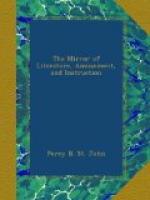The most surprising form of this experiment is when we use a coin from which the inscription has been either wholly obliterated, or obliterated in such a degree as to be illegible. When such a coin is laid upon the red hot iron, the letters and figures become oxidated, and the film of oxide radiating more powerfully than the rest of the coin will be more luminous than the rest of the coin, and the illegible inscription may be now distinctly read to the great surprise of the observer, who had examined the blank surface of the coin previous to its being placed upon the hot iron.
In order to explain the cause of these remarkable effects, we must notice a method which has been long known, though never explained, of deciphering the inscriptions on worn out coins. This is done by merely placing the coin upon a hot iron: an oxidation takes place over the whole surface of the coin, the film of oxide changing its tint with the intensity or continuance of the heat. The parts, however, where the letters of the inscription had existed, oxidate at a different rate from the surrounding parts, so that these letters exhibit their shape, and become legible in consequence of the film of oxide which covers them having a different thickness, and therefore reflecting a different tint from that of the adjacent parts. The tints thus developed sometimes pass through many orders of brilliant colours, particularly pink and green, and settle in a bronze, and sometimes a black tint, resting upon the inscription alone. In some cases the tint left on the trace of the letters is so very faint that it can just be seen, and may be entirely removed by a slight rub of the finger.
When the experiment is often repeated with the same coin, and the oxidations successively removed after each experiment, the film of oxide continues to diminish, and at last ceases to make its appearance. It recovers the property however, in the course of time. When the coin is put upon the hot iron, and consequently when the oxidation is the greatest, a considerable smoke arises from the coin, and this diminishes like the film of oxide by frequent repetition. A coin which had ceased to emit this smoke, smoked slightly after having been exposed twelve hours to the air. I have found from numerous trials that it is always the raised parts of the coin, and in modern coins the elevated ledge round the inscription, that becomes first oxidated. In an English shilling of 1816 this ledge exhibited a brilliant yellow tint before it appeared on any other part of the coin.




